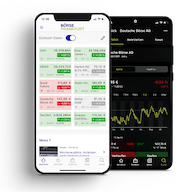Glossary
- Safety cushion
- Sale in the open market
- Saver's Allowance
- Scale for bonds
- Scale for shares
- Schatz future
- SDAX
- Second Quotation Board
- Secondary market
- Secondary purchase
- Sector fund
- Sector index
- Securities
- Securities account
- Securities exchange
- Securities Trading Act
- Seed phase
- Semiannual report (funds)
- Sensitivity (warrants)
- Settlement
- Share
- Share buy-back
- Share price
- Share register
- Shareholder
- Shareholder rights
- Shareholder value
- Shareholders' record
- Shareholder’s right to information
- Sharpe-Ratio
- Shell corporation
- Short position
- Short sale
- SMAX
- SME Growth Market
- SPAC
- Special fund
- Specialised fund
- Specialized fund
- Spot market
- Spread
- Spread certificate
- Squeeze-out
- Standard deviation
- Startup company
- Startup phase
- Steady
- Stock corporation
- Stock cycle
- Stock exchange
- Stock Exchange Act (Börsengesetz)
- Stock exchange monopoly
- Stock index
- Stock market
- Stock market analysis
- Stock market crash
- Stock option
- Stock option plan
- Stock price
- Stock split
- Stop-buy order
- Stop-limit order
- Stop-loss limit
- Stop-loss order
- Stop-market order
- Stop-sell order
- STOXX Europe 50
- STOXX®
- Strike price
- Subscription
- Subscription period
- Subscription rights
- Support buying
- Support Line
- SWAP
- Switch
- Syndicate
- Syndicate bank
- Synthetic bonds
Sharpe-Ratio
A measure for calculating risk-adjusted return of investments.
Named after economist William F. Sharpe, the Sharpe ratio describes the return earned in excess of a risk-free investment while taking into account the average risk in a given fund.
The Sharpe ratio is expressed in absolute terms. In case the result is more than 1, the fund has achieved an excess return. If the result is between 0 and 1, the return is higher than the money market interest rates, but does not match the calculated risk. A negative Sharpe ratio indicates that the return of the security does not even equal that of a risk-free money market investment.
The risk is calculated using the volatility, the measure of the fluctuation of a security price or index to its average value in a set period of time.
Our glossary explains important financial terms and should not leave any questions unanswered. However, if you are missing a definition, please write to us at redaktion@deutsche-boerse.com. We will then include the term if possible.




